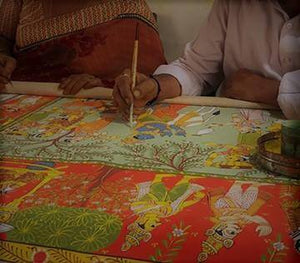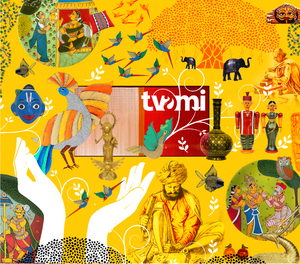
Pujas and Handicrafts: An eternal tryst
The perfect nose, the ideal smile, thin creases, a glorious vahana - if you have ever gone shopping for handmade idols of gods and goddesses, you’ll know that these are some of the things that puja lovers look for before they purchase their chosen piece. To the naked eye, many of the idols might look the same, but to a connoisseur of puja shopping, much like an artist, the differences are obvious.These idols are, of course, just one example of the many puja items on prominent display during the festive season of India, typically from September to early January.
Handicraft plays an integral role in India’s festivities during the puja season - from the one-of-a-kind idols to the pandals to the innovative use of natural elements for decorations or creation of memorabilia. While many art forms incorporate tributes to the divine during this period, India’s realm of traditional art is largely populated by craftforms that started as a means to pay tribute.
History of worship and handicraft
Mata-ni-Pachedi from West India was born out of faith and the desire to worship. The Vaghari community of Gujarat were banned from temples, so they decided to create their own shrines and thus arose Mata-ni-Pachedi, translating literally to “behind the mother Goddess”. This style is focused on painting the divine form on cloth with natural dyes and a bamboo pen, to pay homage to their goddesses.
Sholapith, too, has a devotional history, with the stem of the shola plant being a regular at religious ceremonies and handcrafted sholapith items, created with dried shola stems, being used as decor or crowns for the deities.
Gambhira, another artform from the eastern part of the country, is famous for its bamboo and wooden masks, the latter usually made from neem tree wood. These were, and still are, used in performances to invoke Lord Shiva.
Golu dolls, popular in South India during the days leading up to Dussehra, focus on representations of the Hindu deities and family life. They also show the deities indulging in activities such as Goddesses Saraswsati and Lakhmi sailing on a boat. The dolls are arranged at different levels, with people right at the bottom and the deities closer to the top. Golu dolls are handcrafted and painted by artisans.
Sanjhi, with its origins in the northern part of India, had its debut at temples dedicated to Lord Krishna, the delicate paper-stencilling art-form becoming a popular way to create rangolis for rituals and “paper paintings” of Radha-Krishna.
Needless to say, these folk arts have survived, but have they thrived?
Adapting to 2021
Today, with the popularity of eco-friendly pandals and a demand for sustainable goods, languishing artforms that were suffering during the pandemic are being revived, albeit slowly. Artisans have also adapted their crafts to meet the needs of modern demand, while still retaining the essence of their religious past.
Sholapith artisans have diversified from just creating decor for the gods to creating elegant light streamers, some with intricately made flowers, hair pins, and showpieces, which give the effect of being made from marble when looked at from a slight distance.
Sanjhi artisans have diversified their subjects to include wild animals, birds, and the Tree of Life, without straying too far from their roots. Gambhira as a craft has expanded to include a variety of wooden showpieces, from long boats to tribal masks, each item unlike any other in the world.
Golu dolls have had some competition from mass-produced dolls, but the massy dolls are no match for the detailing of each handcrafted Golu doll. In fact, many families treat them as heirlooms as each handcrafted doll has its own unique, detailed, characteristic features.
Mata-ni-Pachedi artisans are still focused on their subject but the cloth paintings make for graceful decor.
Another heartwarming observation is the change in consumer mindset. People are demanding handcrafted products, not just to support the local artisan, but because they know that handmade items cannot be mass-produced. Each version of the product is bound to be different, with its own little quirks, its identifying markers.
It is common for rural artisans to use natural elements when working on their crafts as they are limited to what is available around them. This comes as a big relief to eco-conscious consumers, young and old, and to those who view nature as divine.
Needless to say, with this move towards sustainability, the demand for uniqueness, and a growing desire to incorporate visual elements of India’s diverse culture into modern-day living, consumers and artisans are primed for an aesthetic celebration of Indian heritage.
What better way to indulge in the celebration than by supporting your local artisans, people who have been preserving our heritage with, quite literally, their own hands? If you want to explore the stories, crafts, or products of India’s many artisans, visit www.tvami.com



Leave a comment